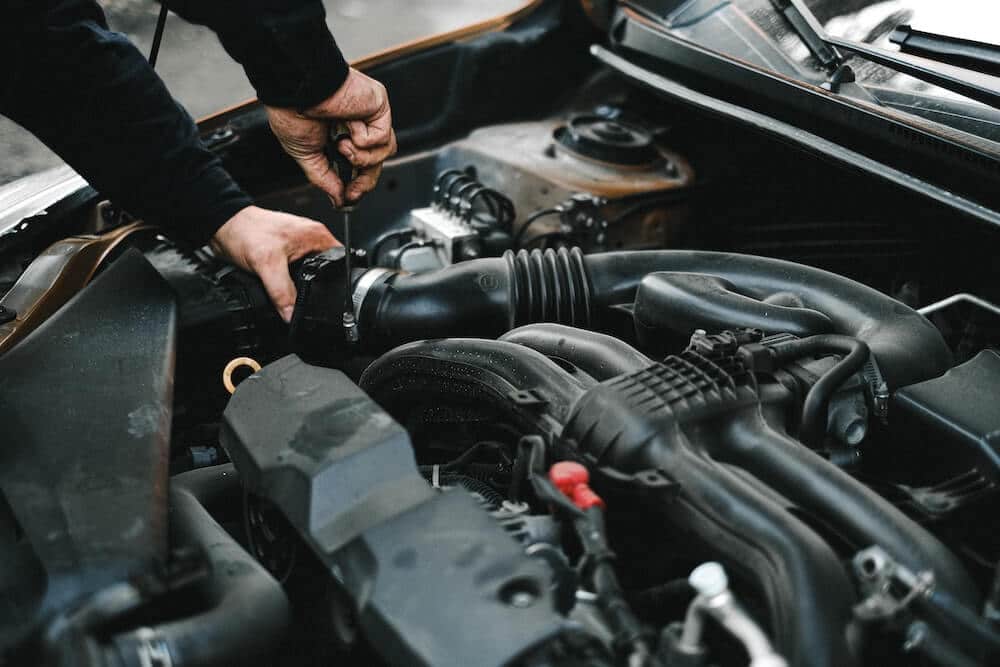What Causes Cars to Catch on Fire?

As a motorist, you probably regularly see fellow drivers broken down on the side of the road. They might be there because the vehicle ran out of gas, its timing belt or chain gave out, its battery went dead, its tire went flat, or for various other reasons.
Fortunately, occurrences in which motorists find themselves on the side of the road because their vehicles are on fire are rare.
If you’ve ever wondered what causes cars to catch on fire, then you’re in the right place. We’ll highlight some of the more common reasons these blazes occur below and, at the same time, impart some insight about how to prevent such an occurrence from happening to you.
Factors That Give Way to Car Fires
Four primary factors give way to car fires. These are:
- Crashes
- Poorly maintained vehicles
- Flammable substance protocol violations
- Defective auto parts or mechanical flaws
We’ll tackle how each of these may occur below.
How Auto Accidents Lead to Car Fires
A crash’s impact, depending on the angle at which it occurs, can result in damage to the gas tank, resulting in a potentially hazardous situation requiring clean-up or resulting in a fireball.
This outcome is more likely to happen if a rear-end crash caused by reckless driving such as tailgating or distracted operation of a vehicle occurs. Law enforcement officers are diligent in pulling over motorists engaging in reckless driving behaviors to minimize the chances of potentially deadly crashes occurring.
Police officers are often quick to pull over motorists who fail to abide by Move Over laws. These laws require motorists to navigate their vehicles into an adjacent lane, away from law enforcement, emergency responders, tow trucks, and stranded motorists they encounter along the interstate.
Law enforcement officers may issue citations if motorists fail to do so. Why? They do so because they know that a fast-moving vehicle and a stationary one don’t mesh well. They know that a fast-paced rear-end crash could easily cause the stranded motorist’s gas tank to ignite.
How Do Poorly Maintained Vehicles Give Way to Fiery Crashes?
If you’ve ever touched a hood after you’ve arrived at your destination, then you know how hot it can get. It’s even hotter under it.
You’ll often see a myriad of warnings on your fluid receptacles and elsewhere under your hood, warning you of the potential of suffering burns if you touch them. Car fires are most apt to get underway under your hood because:
- Wiring is loose or becomes cracked
- Oil leaks develop
- There are fluctuations in engine temperature
- Fuses blow
- Fluid or fuel levels rapidly fluctuate
- An oil cap wasn’t properly resecured
Almost every owner’s manual lists recommended regular maintenance the vehicle should undergo. This includes exchanges of all fluids to ensure the proper composition, regular belt and wiring inspections, and the replacement of fuses. Ignoring these and more pressing concerns that creep up may leave a vehicle vulnerable to catching on fire.
How Improper Transportation of Flammable Substances Causes Fires
If you’ve ever picked up a gas canister, then you’ve likely seen all the different warning labels on it warning you of the dangers associated with transporting flammable substances. Gasoline is certainly a common substance that individuals transport in containers in their vehicles to power their lawnmowers, yard equipment, generators, and other cars on empty on their property.
Many individuals think that putting these containers on their car seats, the floorboard of their cars, or in their truck beds or trunks is safe. This isn’t necessarily the case, though.
There’s always the potential of them shifting around. All it takes is a side-impact or rear-end crash, the gasoline intermixing with another combustible substance, you lighting up a cigarette, or parking next to a heat source for a fire to ignite.
Even spilled gasoline that’s never properly cleaned up may appear dry on the surface yet still leave behind residue that, when exposed to the right circumstances, may ignite, causing a blaze.
Also, while many people know that gasoline is flammable, they don’t seem to readily identify other items that they might carry in their vehicle that may leave them at risk of being injured in a fire. Some additional flammable items include:
- Pesticides
- Spray paint
- Butane (which is in many household lighters)
- Propane
- Kerosene (the oil that fills many space heaters)
- Paint solvents
- Oils
- Dry cleaning supplies
Many of us don’t think twice about carrying these items in our vehicles. Each of these (and countless other items) can easily ignite a car fire if transported incorrectly, a crash occurs, or under the right circumstances, though.
How Defective Car Parts Give Way to Car Fires
There have been a variety of auto part defects and operational malfunctions that have resulted in cars ultimately being recalled over the past few decades.
One instance happened in 1978 when 1.5 million Ford Pinto and Mercury Bobcat vehicles were recalled after 180 motorists died due to exploding gas tanks in crashes.
However, gas tank issues aren’t the only concerns that have motivated auto manufacturers and government regulators to issue recalls. Faulty electrical systems, oil fires, engine issues, and tire blowouts have resulted in blazes igniting and have seriously injured or killed motorists.
Tips You Can Employ to Minimize Risk If a Car Fire Occurs
Individuals who find themselves in a burning car often suffer significant burn injuries or lose their lives. They do so because they fail to pull over right away when their car begins to overheat, starts operating differently, or shows signs that something is not right. It’s always best to err on the side of safety and pull over if something seems awry.
If you do have to perform an emergency pullover, you will want to keep your distance from your vehicle. This is particularly effective guidance if you don’t know much about cars to understand what may be awry. You risk suffering burns if a boiling fluid underneath the hood makes contact with your skin. You may also directly expose yourself to flames if the engine, wiring, or other electrical components have ignited.
Keeping a distance from your vehicle also minimizes the chance of a car or auto part striking you. An explosion is a real possibility as a fire spreads to flammable products in the car or the gas line or if the vehicle is struck near its gasoline tank. A distance of at least 100 feet or more is ideal in these situations.
You should always call 911 to render aid and allow firefighters to assess the situation if you believe your car is susceptible to catching on fire.
Also, no matter what you do, remember that returning to your car, whether it appears a fire may erupt or one already has, is never a good idea. This approach results in many individuals who would have otherwise gone unscathed suffering serious burns, smoke inhalation injuries, or loss of life.
Help for Individuals Injured in Car Fires
As someone who has suffered burn injuries, you likely have learned from your doctors that no two cases are the same. If you’ve had the misfortune of suffering third or fourth-degree burns, then you’re more apt to be left with a lifetime of cosmetic flaws, pain, and functional impairments, all of which may affect your quality of life.
No matter whether an auto part defect or a negligent motorist caused your fiery crash, know that you have a right to compensation. Proving liability in these cases isn’t always easy. However, an experienced Baltimore personal injury attorney like one of ours at Belsky & Horowitz, LLC, will have the requisite experience to advocate for you.






